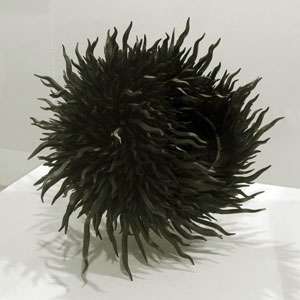Junko Mori
Junko Mori (森 純子, Mori Junko) (born 1974) is a Japanese artist and metalworker born in Yokohama, Japan.

Career
Mori graduated from Musashino Art University in Tokyo in 1997 with her first BA, in three-dimensional design.[1] She then worked as a welder in a factory for nine months.[2] From 1998 to 2000, she studied silversmithing and metalwork at Camberwell College of Arts in London.[3] Mori then spent two years as artist-in-residence at Liverpool Hope University.[4]
Work and holdings
Mori is best known for her hand-forged metal sculptures that are both organic and minimalist, such as Propagation Project, now in the collection of the Honolulu Museum of Art. The Art Gallery of South Australia (Adelaide, Australia), the Birmingham Museum and Art Gallery (Birmingham, England), the British Museum, the Honolulu Museum of Art, the Manchester Art Gallery (Manchester, England), the Museum für Kunst und Gewerbe Hamburg (Hamburg, Germany), the National Museum Cardiff (Cardiff, Wales), the National Museum of Scotland (Edinburgh, Scotland), the National Museums Liverpool, the Ulster Museum, Leeds Museums and Galleries (Temple Newsam) and the Victoria and Albert Museum are among the public collections holding work by Junko Mori.[5]
References
- "A Very Large Propagation Project of Textured Spikes | Mori, Junko | V&A Search the Collections". V and A Collections. 2019-03-26. Retrieved 2019-03-26.
- "Real Steel | Junko Mori | Articles - Crafts Council". www.craftscouncil.org.uk. Retrieved 2019-03-26.
- "A Very Large Propagation Project of Textured Spikes | Mori, Junko | V&A Search the Collections". V and A Collections. 2019-03-26. Retrieved 2019-03-26.
- "Real Steel | Junko Mori | Articles - Crafts Council". www.craftscouncil.org.uk. Retrieved 2019-03-26.
- Adrian Sassoon Gallery
External links
- Junko Mori at Adrian Sassoon
- Interview with Junko Mori
- "'A Very Large Propagation Project of Textured Spikes'". Metalwork. Victoria and Albert Museum. Retrieved 2007-08-17.
- 'Propagation Project; Ring of Small Petals'. Metalwork. British Museum. Retrieved 2018-09-01